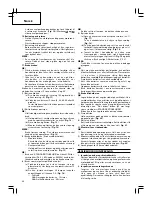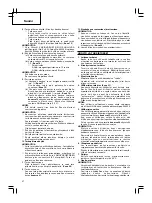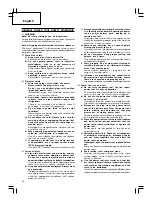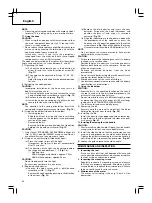
English
43
4. Disconnect the charger’s power cord from the
receptacle.
5. Hold the charger firmly and pull out the battery.
NOTE:
After operation, pull out batteries from the charger
first, and then keep the batteries properly.
Regarding electric discharge in case of new
batteries, etc.
As the internal chemical substance of new batteries
and batteries that have not been used for an extended
period is not activated, the electric discharge might
be low when using them the first and second time.
This is a temporary phenomenon, and normal time
required for recharging will be restored by recharging
the batteries 2 – 3 times.
How to make the batteries perform longer
(1) Recharge the batteries before they become completely
exhausted.
When you feel that the power of the tool becomes
weaker, stop using the tool and recharge its battery.
If you continue to use the tool and exhaust the electric
current, the battery may be damaged and its life will
become shorter.
(2) Avoid recharging at high temperatures.
A rechargeable battery will be hot immediately after
use. If such a battery is recharged immediately after
use, its internal chemical substance will deteriorate,
and the battery life will be shortened. Leave the battery
and recharge it after it has cooled for a while.
CAUTION:
䡬
When the battery charger has been continuosly used,
the battery charger will be heated, thus constituting
the cause of the failures. Once the charging has been
completed, give 15 minutes rest until the next
charging.
䡬
If the battery is recharged when it is warm due to
battery use or exposure to sunlight, the pilot lamp
map light in green.
The battery will not be recharged. In such a case, let
the battery cool before charging.
䡬
When the pilot lamp flickers in red (at 0.2-second
intervals), check for and take out any foreign objects
in the charger’s battery installation hole. If there are
no foreign objects, it is probable that the battery or
charger is malfunctioning. Take it to your authorized
Service Center.
PRIOR TO OPERATION
1. Setting up and checking the work environment
Check if the work environment is suitable by following
the precautions.
HOW TO USE
1. Confirm the cap position (see Fig. 4)
The tightening torque of this unit can be adjusted
according to the cap position, at which the cap is set.
(1) When using this unit as a screwdriver, line up the one
of the numbers “1, 4, 7 ... 22” on the cap, or the black
dots, with the triangle mark on the outer body.
(2) When using this unit as a drill, align the cap drill
mark “
” with the triangle mark on the outer
body.
CAUTION:
䡬
The cap cannot be set between the numerals “1, 4, 7
... 22” or the black dots.
䡬
Do not use with the cap numeral between “22” and
the black line at the middle of the drill mark. Doing so
may cause damage. (See Fig. 5)
2. Tightening torque adjustment
(1) Tightening torque
Tightening torque should correspond in its intensity
to the screw diameter. When too strong torque is
used, the screw head may be broken or be injured.
Be sure to adjust the cap position according to the
screw diameter.
(2) Tightening torque indication
The tightening torque differs depending on the type
of screw and the material being tightened.
The unit indicates the tightening torque with the
numbers “1, 4, 7 ... 22” on the cap, and a black dots.
The tightening toque at position “1” is the weakest
and the torque is strongest at the highest number.
(See Fig. 4)
(3) Adjusting the tightening torque
Rotate the cap and line up the numbers “1, 4, 7, ...
22” on the cap, or the black dots, with the triangle
mark on the outer body. Adjust the cap in the weak or
the strong torque direction according to the torque
you need.
CAUTION:
䡬
The motor rotation may be locked to cease while the
unit is used as drill. While operating the driver drill,
take care not to lock the motor.
䡬
Too long hammering may cause the screw broken
due to excessive tightening.
3. Change rotation speed
By making a combination of the switch-over of “HIGH”
or “LOW” with the shift knob and the switch-over of
Power mode (P) or Save mode (S) with the lever on
the side of the handle, the rotational speed can be set
to four (4) steps. (See “SPECIFICATIONS”.)
䡬
How to switch over “HIGH” or “LOW”
Operate the shift knob to change the rotational speed.
Move the shift knob in the direction of the arrow (see
Figs. 6 and 7).
When the shift knob is set to “LOW”, the drill rotates
at a low speed. When set to “HIGH”, the drill rotates
at a high speed.
䡬
How to switch over the Power mode (P) or Save
mode (S)
To set to the Power mode (P), slide the lever on the
side of handle to the lower side, and to set to the
Save mode (S), slide the lever to the upper side.
(Figs. 8 )
CAUTION:
䡬
When changing the rotational speed with the shift
knob, confirm that the switch is off.
Changing the speed while the motor is rotating will
damage the gears.
䡬
When setting the shift knob to “HIGH” (high speed)
and the position of the cap is between“16” and “22”,
it may happen that the clutch does not engaged and
that the motor is locked. In such a case, please set the
shift knob to “LOW” (low speed).
䡬
If the motor is locked, immediately turn the power
off. If the motor is locked for a while, the motor or
battery may be burnt.
䡬
In the work of the save mode (S), avoid the continuous
screw-tightening as temperature of electronic
components of the converter switch increases.
䡬
To extend the lifetime, the lithium-ion battery equips
with the protection function to stop the output.
Therefore, if the tool is overloaded, the motor may
stop. However, this is not the trouble but the result of
protection function. In this case, release the switch of
tool and eliminate the causes of overloading.









































